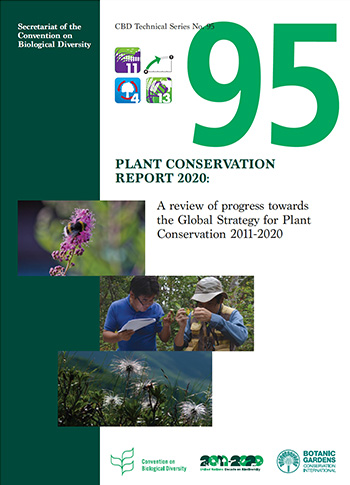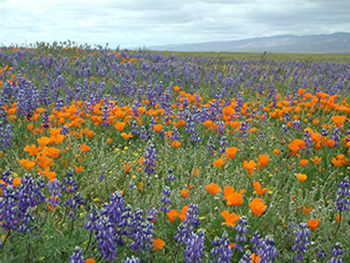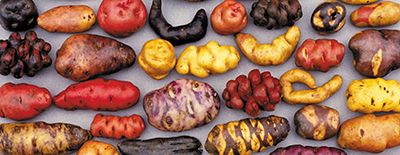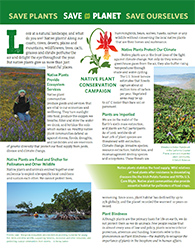Native Plant Conservation Campaign News: Progress report released for the Global Strategy for Plant Conservation
October 1, 2020
A new Report on the historic Global Strategy for Plant Conservation (GSPC), documents its progress in encouraging collaborative action by the  world’s plant science and conservation communities.
world’s plant science and conservation communities.
 world’s plant science and conservation communities.
world’s plant science and conservation communities.The GSPC was adopted unanimously by the 187 Parties to the Convention on Biological Diversity in 2002. It set 16 outcome-orientated quantitative targets to achieve measurable goals by o 2010. The GSPC was the first agreement by the global community in history to establish quantitative targets for biodiversity conservation. The Native Plant Conservation Campaign and our affiliate group the California Native Plant Society were fortunate to participate in the development of the GSPC.
In 2010, a set of revised targets for 2020 were agreed to by the Convention on Biological Diversity, with a decision that implementation of the GSPC should be pursued as part of the broader framework of the Strategic Plan for Biodiversity that is currently in development.
(Note: that the U.S. remains the sole member of the United Nations that has not ratified the Convention on Biological Diversity - former holdouts Iraq and Somalia ratified the Convention in 2009. Therefore, unlike the rest of the international community, the government of the U.S. does not actively implement the GSPC. However a number of non-governmental organizations, including Botanic Gardens Conservation International – U.S. and the Native Plant Conservation Campaign are working to pursue GSPC Targets in this country.)
The new September 2020 Report on the GSPC found that many new initiatives have been developed to achieve GSPC targets. These include the establishment of a World Flora Online and a Global Tree Assessment. The World Flora Online is an open-access web-based compendium of the world’s 350,000 species of vascular plants and mosses developed by a consortium of over 40 institutions. The Global Tree Assessment sought to have completed conservation status assessments (Red List) for the world’s tree species by 2020. Currently, the Assessment finds one in five tree species globally are threatened with extinction.
The GSPC progress Report was based partially on information provided by 61 countries on their progress towards the GSPC Targets. The majority reporting some progress towards the global Targets. Targets 1, 2 and 14 (online floras, species conservation status assessment and improving public awareness of plant diversity, see below) were most likely to be achieved at the national level.
Below we summarize some examples of progress towards GSPC Targets (this does not cover all 16 Targets. For information on all Targets, read the GSPC Report):
TARGET 1: AN ONLINE FLORA OF ALL KNOWN PLANTS.
A beta version of the World Flora Online website is available for searching on-line. The datbase includes 1,325,205 names, 350,634 accepted species, 56,141 images, 437,915 descriptions, 129,179 distributions and 1,382,149 references.
TARGET 2: AN ASSESSMENT OF THE CONSERVATION STATUS OF ALL KNOWN PLANT SPECIES, AS FAR AS POSSIBLE, TO GUIDE CONSERVATION ACTION.
The best progress towards this target was made for trees. The Global Tree Assessment of tree conservation status shows that 58% of the world’s 60,008 tree species have a completed conservation assessment. Around 46% of the assessed trees are considered threatened regionally and 38% of all assessed trees are threatened globally. This means that at least 22% of all tree species are threatened with extinction globally.
The 2019 Global Assessment Report on Biodiversity and Ecosystem Services also marked progress towards this Target
TARGET 4: AT LEAST 15 PER CENT OF EACH ECOLOGICAL REGION OR VEGETATION TYPE SECURED THROUGH EFFECTIVE MANAGEMENT AND/OR RESTORATION
Botanic Gardens Conservation International established the Ecological Restoration Alliance of Botanic Gardens to make it easier for botanic gardens to share expertise in support of native plant restoration around the world. Further the United Nations declared 2021-2031 a Decade of Ecosystem Restoration, calling for the restoration of 350 million hectares of degraded land between now and 2030. This restoration should generate $ 9 trillion in ecosystem services and take an additional 13-26 gigatons of greenhouse gases out of the atmosphere.
Numerous, primarily forest, restoration efforts in Africa are working towards this Target. Further, In November 2014, the first Mexican Symposium on Restoration was held. This attracted 316 participants from 43 institutions and resulted in a publication of Mexican experiences
The Report notes that limited availability of locally appropriate native seed and other plant materials is a significant barrier to the achievement of this Target. France is working to address this. The Federation of National Botanical Conservatories established a certification program in 2015. Since 2017, certified plants and seed have become a brand of the French Office for Biodiversity. It guarantees the geographical origin of plants and seeds to be used during ecological restoration or landscaping projects.
TARGET 5: AT LEAST 75% OF THE MOST IMPORTANT AREAS FOR PLANT DIVERSITY OF EACH ECOLOGICAL REGION PROTECTED, WITH EFFECTIVE MANAGEMENT IN PLACE FOR CONSERVING PLANTS AND THEIR GENETIC DIVERSITY
Globally, Plantlife UK and the Royal Botanic Gardens, Kew are leading efforts to identify and protect Important Plant Areas (IPAs) throughout the world. As of 2017, more than 2500 IPAs had been identified.
 In the United States, several states including Colorado and New Mexico, are engaged in IPA identification efforts. In California, the California Native Plant Society is developing IPA assessments.
In the United States, several states including Colorado and New Mexico, are engaged in IPA identification efforts. In California, the California Native Plant Society is developing IPA assessments.TARGET 9: 70%F THE GENETIC DIVERSITY OF CROPS INCLUDING THEIR WILD RELATIVES AND OTHER SOCIO-ECONOMICALLY VALUABLE PLANT SPECIES CONSERVED, WHILE RESPECTING, PRESERVING AND MAINTAINING ASSOCIATED INDIGENOUS AND LOCAL KNOWLEDGE
Towards this Target, the UN Food and Agriculture Organization released Voluntary Guidelines for the Conservation and Sustainable Use of Crop Wild Relatives and Wild Food Plants In 2017. That same year, the Crop Science Society of America published a special journal issue on conservation of crop wild relatives, and the International Union for the Conservation of Nature Conservation Planning Specialist Group released an Interactive Toolkit for Crop Wild Relative Conservation Planning
 According to the GSPC Report, there are currently 7.4 million collection of crop wild relatives stored in 1,750 gene banks around the world. The Genesys database, allows users to explore the world’s crop diversity conserved in these gene banks through a single website.
According to the GSPC Report, there are currently 7.4 million collection of crop wild relatives stored in 1,750 gene banks around the world. The Genesys database, allows users to explore the world’s crop diversity conserved in these gene banks through a single website.TARGET 11: NO SPECIES OF WILD FLORA ENDANGERED BY INTERNATIONAL TRADE
As in most areas of conservation, plants have been traditionally overlooked in efforts to protect biodiversity from overexploitation for commercial trade. The problem is discussed in a 2018 statement by the joint Plant Species Survival Commissions of the International Union for the Conservation of Nature. In 2020, TRAFFIC – the Wildlife Trade Specialists released a report on the issue: The Invisible Trade - Wild plants and you in the time of COVID-19.
The GSPC has addressed the problem by promoting communication between the parties to the Convention on International Trade in Endangered Species of Wild Fauna and Flora (CITES) and the GSPC. One result is that the plants covered by CITES have been expanded beyond ornamental species (such as orchids and cacti) to some major commercial groups of internationally traded species such as timbers and medicinal plants.
TARGET 14: THE IMPORTANCE OF PLANT DIVERSITY AND THE NEED FOR ITS CONSERVATION INCORPORATED INTO COMMUNICATION, EDUCATION AND PUBLIC AWARENESS PROGRAMMES
This is one of the core objectives of the NPCC. We work with mainstream environmental groups, elected officials and the media. We publish articles and presentations to improve understanding of both (i) the importance of plants to life on earth and (ii) that plant science and conservation are severely underfunded, understaffed and underappreciated which puts all life on earth at risk.
- Solving the biodiversity crisis also requires funding for plant conservation. Letter published in Science Magazine by the NPCC and other plant conservation and garden groups. January 17, 2020
- Save Plants, Save The Planet, Save Ourselves – Native Plants and Nature Based Solutions to Climate Change And Other Threats to Humanity. Emily B. Roberson and Doug Tallamy. June, 2019.
- Brochure "Save Plants, Save the Planet, Save Ourselves (April, 2017).
- Ecosystem Services Infographic Fact Sheet explains the variety and value of ecoystem services provided by native plant communites, 2016
According to the GSPC Report, botanic gardens attract some 500 million visitors annually and are amongst the leading organizations implementing this Target. In recent years, GSPC reports “spectacular” growth of new botanic gardens with a strong focus on public education. In Europe, Fascination of Plants Day continues to grow in popularity with over 860 events held in 48 countries around the world in 2019. Further, biodiversity celebrations such as Earth Day and Endangered Species Day are incorporating more plant information every year.
TARGET 15: THE NUMBER OF TRAINED PEOPLE WORKING WITH APPROPRIATE FACILITIES SUFFICIENT ACCORDING TO NATIONAL NEEDS, TO ACHIEVE THE TARGETS OF THIS STRATEGY
In 2002, the NPCC released Barriers To Native Plant Conservation In The United States: Funding, Staffing, Law It found, among other things, that at that time, the Bureau of land Management employed only 68 botanists nationwide to manage 264 million acres (1 botanist per 4 million acres) while the U.S. Forest Service employed only 128 botanists at that time.
In 2009, the Chicago Botanic Garden and Botanic Gardens Conservation International U.S. released an assessment of the current and future botanical capacity in the United States federal agencies. The assessment found that the United States remained critically understaffed in botany and, further, was predicted to lose nearly half of its workforce with botanical expertise by 2019. Further, between 1988 and 2009, more than half of university Botany departments and offerings of botany degrees were eliminated.
In 2015, work began towards federal legislation to address these problems. In 2017, the Botanical Sciences and Native Plant Materials Research, Restoration, and Promotion Act (aka Botany Bill) was introduced in the U.S. House of Representatives. Today the bill has broad bipartisan support in both Houses of Congress and we hope it will move forward in the next congress.
Internationally, the news is not good. According to the Report, botanical capacity is actually declining in many nations. The Report states that in some cases the non-governmental sector (e.g. botanic gardens and other non-profit conservation organizations, as well as for-profit businesses and self-employed individuals) are stepping in, providing botanical training, expertise and infrastructure where it otherwise would not exist.
TARGET 16: INSTITUTIONS, NETWORKS AND PARTNERSHIPS FOR PLANT CONSERVATION ESTABLISHED OR STRENGTHENED AT NATIONAL, REGIONAL AND INTERNATIONAL LEVELS TO ACHIEVE THE TARGETS OF THIS STRATEGY
This is also a core objective of the NPCC. In the U.S., The NPCC has addressed this Target by creating a national native plant society of the United States with 57 affiliate plant organizations. NPCC has also worked to increase collaboration among U.S. plant conservation groups such as the Botanic Garden Conservation International U.S., the Center for Plant Conservation, the American Public Gardens Association , the Garden Club of America, the Plant Conservation Alliance Non-federal Cooperators (a network of several hundred non-governmental organizations and businesses which supports federal botany programs) and the NPCC. One example of this collaboration is the 2020 letter to the journal Science addressing underfunding of plant conservation in the U.S.
NPCC also works to improve communication and collaboration between the plant conservation community and mainstream wildlife and other conservation organizations. Some good results of these efforts can be found here.
- Read the full GSPC Report for data, details, examples of national projects implementing the GSPC, discussion of challenges and problems, and the GSPC’s plans for next steps.
- Read the press release for the Report from the Convention on Biological Diversity
Photos: Wild Potatoes © Guardian UK, Carrizo Plain IPA CA © Emily B. Roberson

